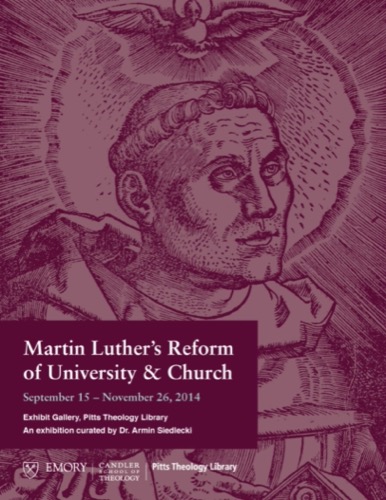Martin Luther's Reform of University and Church

Introduction
Theological education underwent a fundamental transformation in the late fifteenth and early sixteenth century. New universities were established across Europe, including the University of Wittenberg (founded 1502), and curricula were changed to reflect the new intellectual impulses of the Renaissance, including a renewed appreciation of classical authors and of the early Church Fathers that is well summed up by the motto ad fontes—“to the sources.” To this end, new academic chairs were established to teach Greek and Hebrew and to engage students in ways that went beyond the traditional methods of medieval scholasticism. At the same time the rediscovery of classical philosophy and aesthetics fostered a new mindset that often placed the human person at the center of philosophical endeavors as well as artistic representation.
The Protestant Reformation unfolded against the intellectual backdrop of these new impulses and innovations, and many Renaissance ideas were central to calls for reform by Catholic humanists such as Desiderius Erasmus or Protestant Reformers such as Martin Luther and Philipp Melanchthon. However, the distinctive Protestant contribution to the transformation of theological education in the sixteenth century was perhaps the sense of mission and vocation, the appropriation of Renaissance learning, not only to the edification of humanity nor simply to the service and greater glory of God, but first and foremost to the purpose of situating the word of God in the world and of proclaiming it to the world. In the words of Reformation historian Timothy Wengert: “The unique combination of Renaissance and reformation in Wittenberg’s university reform reminds us of what we Christians, situated in an increasingly anti-intellectual world, dare never forget. Languages, good literature, scientific investigation, far from being bars to faith are in fact gifts of creation. However, what the church has to offer the Copernicuses and Galileos of our day is not animosity but a way of situating human beings in the universe: as believers in God and servants to the neighbor, all the while caring for this beautiful blue planet that God has given us.”
This exhibit presents the context of Renaissance learning and displays early printed editions of texts that influenced educational reform. It includes the early printed editions of the biblical text in its original languages, as well as the language tools available to translators and theologians. It also presents examples of contributions by educators such as Erasmus, Melanchthon and Luther, as well as of the public controversies between Martin Luther and two of the most renowned centers of learning—the University of Paris and the University of Leuven. True to the two-fold impulse of learning and vocation that characterized Protestant theological education in the sixteenth century, this exhibit will also present the application of theological learning at institutions such as the University of Wittenberg and its impact beyond the academic contexts in churches and Christian homes.

Exhibition catalog: Read Online | Download PDF